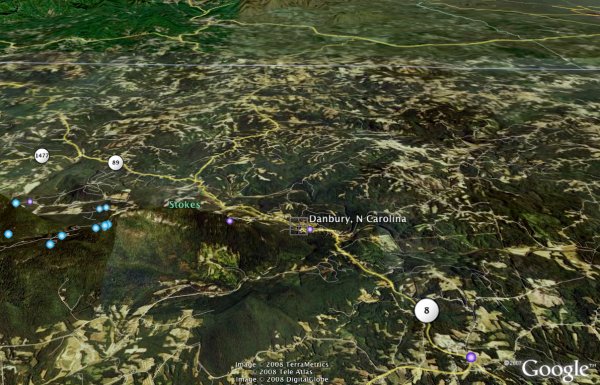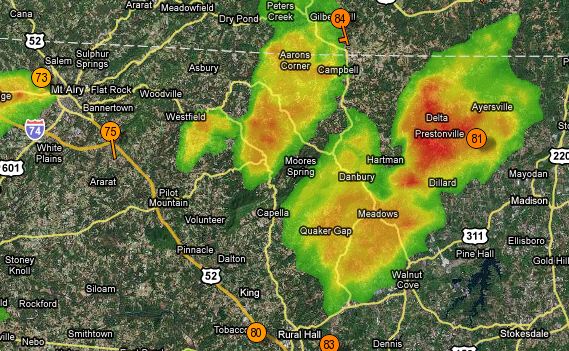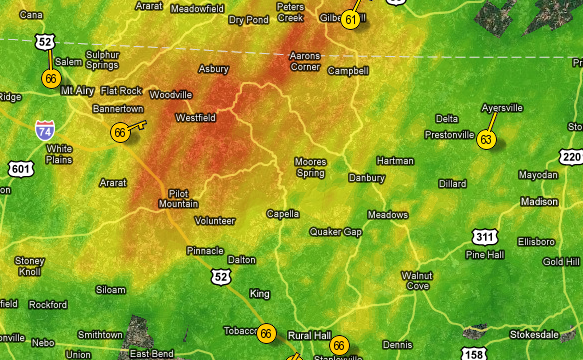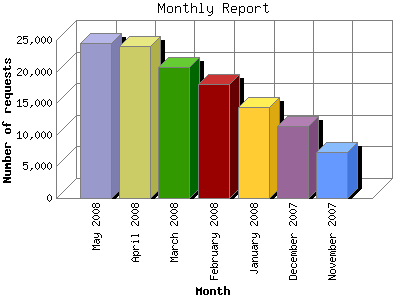Road trip: The headwaters of the Dan River
The Dan River begins in the foothills of the Blue Ridge Mountains in Virginia. The area includes Stokes and Surry counties in North Carolina and Patrick County in Virginia. I took a little road trip through this area today. It was hot, but I just couldn’t take another day of sitting inside with the air conditioning running. The Jeep has no air conditioner, but it’s nice and cool if you take the windows out and keep moving.

The Dan River headwaters in Google Earth
A farmstead near Claudville, Virginia
Outbuilding near Claudville, Virginia
A cherry tree near Claudville, Virginia
A church near Claudville, Virginia
Theological innovation near Westfield, North Carolina. If you can’t read it, the sign says “Chestnut Ridge Progressive Primitive Baptist Church.”
Artistic innovation — a yard art factory near Mount Airy, North Carolina
Butterfly weed near Claudville, Virginia
A majestic poplar, as big as an oak, near Francisco, North Carolina
A cottage on Virginia Route 103
A cottage on N.C. 8 near the Virginia line.
Hay work is going on everywhere right now. With the price of grain sky high, the hay must be really valuable to the local farmers. These days, most of the hay goes into big, industrial-size bales.
Still, some people still make old-fashioned hayride bales, and boys still learn how to do it.
At least the garden likes the hot weather
Deckage
A ride up Booger Swamp Road
Yes there is a Booger Swamp Road. I believe it’s in Zip Code 27055 if you want to Google it for yourself.
Californians, here’s what young Carolina flue-cured tobacco looks like. This is the kind of tobacco that is made into cigarettes. This is on Center Road, one turn off Booger Swamp Road. I’ll try to show you more of the tobacco crop as the season progresses.
Here’s the farm machine du jour. I believe it’s a seed drill, and it’s probably out to plant soybeans. For some reason, I find farm machinery fascinating. This is on Shallowford Road near Lewisville. All three of these photos are in Yadkin County.
We do have readers…
The drama of daisies and stuff
Daisies are so humble, but it’s flattering when they choose to grow in the weedpatch beside your driveway. Around here people mostly mow them down.
Every morning and every evening I go out for a walk to see how the grass and clover are coming along. It’s chiefly in the morning that you notice a difference. The clover got off to a very slow start, but some of it is starting to look like real clover. It’ll be a red-letter day when the first clover blooms. I sowed three kinds of clover — red, white, and Ladino clover. I believe this is red clover.
This bank was skinned back to the subsoil when the bulldozer made the driveway. I’m still weeks away from a vigorous stand of grass, but the peach fuzz is promising.
A baby tomato. It’s amazing how fast things grow in raised beds.
Vidalia onions
I would continue to testify that, awesome though California’s produce is, there are three things grown in the Southeast that California can’t duplicate: Vidalia onions (from Georgia, of course), proper summer tomatoes, and mountain cabbage.
Vidalia onions are showing up in all the stores here. The large ones can be expensive. The medium-size onions are very reasonably priced. I don’t know why it took me so long to figure it out, but I now understand the source of the soggy onions we had during the winter, both in California and here in the Southeast. The onions are imported from Central America and Peru. I’m guessing that they must be transported on ships with no ventilation, so the outers layers have already started to rot by the time they get here.
I’ll have plenty more on tomatoes this summer. I hope to visit a cabbage patch in Carroll County, Virginia, before too much longer.
Today's photos, in no particular order
The local power company, Energy United, has been clearing trees around the power lines up on Duggins Road. I stopped and had a nice chat with the two supervisors about going as easy on the greenery as possible. They were very nice and didn’t disagree at all. Part of what they’re doing, though, is an infrastructure upgrade. They’re getting ready to replace the old copper and steel overhead wiring with aluminum and steel wiring. They say that the new wiring is stronger, less likely to melt when something falls on it, and has lower electrical resistance.
The local strawberries are in. These were in a produce market at Walnut Cove, and they told me the berries were grown in Madison.
In the agricultural history department, this old sickle caught my eye. It’s beside the main drag in Walnut Cove.
It’s meant to be pulled by a mule. It takes power from a rear wheel, and, through a shaft and cam, converts the wheel’s motion to reciprocal motion to drive the sickle. This machine was made by B.F. Avery & Sons Co., in case anyone is doing a web search on old machinery.
Abandoned homeplaces are always fascinating. There are lots of them around here, and we take them for granted. But they can’t be common everywhere. I would imagine it takes certain trends and circumstances to create abandoned homesteads, things like cheap land, changing technology, more suburbanized ways of making a living, migration patterns, and so on. In short, not many people want to live that way anymore, and the places aren’t worth keeping up. It’s a shame.
Old houses are a repository of vanishing culture. They’re also a repository of heirloom varieties of flowers, shrubs, and fruit trees. This particular old house, on Stewart Road on the way to Walnut Cove, has two huge growths of roses, one pink, one deep red. The front porch is large and is still there, but it’s been taken by overgrowth.
An overgrown outbuilding. It’s all so art nouveau.
Honeysuckle everywhere. Right now you can drive for miles and miles on the backroads and never leave the scent of honeysuckle.
Rain today = tomatoes tomorrow

The reddest part of this squall missed me, but it left an eighth of an inch of rain yesterday.

Today we have real rainy-day rain, and it may go on for hours.
What I last lived in thunderstorm country (17 years ago), Internet radar didn’t exist. Now you can easily see when rain is approaching, and how much.
After they’ve had time to slurp up some of this rain, I’ll have some photos to show what the rain did for my baby tomatoes, peppers, peas, and beans.

